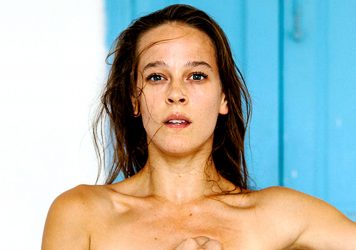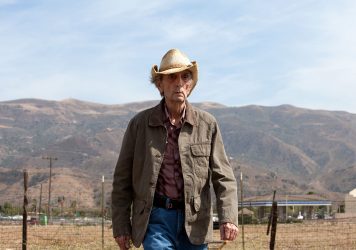
The players behind this year’s festival offer their personal viewing recommendations.
With 243 features to choose from over just 12 days, it can be hard to see the wood for the trees when choosing what to watch at the BFI London Film Festival. You might want to see the big ticket gala films, check out the latest from your favourite director, or take a lucky dip. It is always, though, worth heeding what the programmers themselves single out. Here is a selection of 10 films, in no particular order, flagged up by the LFF’s official selectors as well worth seeing.
Debut filmmaker Cory Finley’s treacly dark play of wits sees two precocious and privileged teenage girls plotting a murder in the rarified mansion-filled suburbs of Connecticut. For the most part this is a deliciously sharp two-hander between The Witch’s Anya Taylor-Joy as Lily and Me and Earl and the Dying Girl’s Olivia Cooke as Amanda, a duo whose rekindled childhood friendship has deadly consequences for Lily’s annoying step father. But Anton Yelchin brings surprising pathos to his final role as the small-time drug dealer the girls dupe into being involved in their grimly amusing plot. Like other classics about wicked teens, Cruel Intentions, Heavenly Creatures and Heathers, this is clever, visceral, twisted and thrillingly entertaining. Tricia Tuttle
I wanted to write about Lucky anyway. But now, with the passing of its much-loved lead Harry Dean Stanton, what more is there to say about one of the great character actors, and characters, of American cinema? Well, one thing, perhaps the only thing, is to talk about the man through the work. Though a longtime fan, my distinct aversion to “Grumpy Old Men” movies – which seem to coat a thin veneer of rebelliousness over reactionary conservatism – the story of an irascible nonagenarian staring down mortality, even tailored to its star, had little appeal.
Such preconceptions reckon without the graceful modulation of debut director John Carroll Lynch, himself a fine character actor (Fargo, Zodiac). Tenderly, yet unsentimentally and with much humour, he expands Lucky’s canvas to more universal reflections on human transience. Then there’s Harry Dean’s genuinely great performance: yes, one steeped in his own persona, but as open and vulnerable as his previous career peak in Paris, Texas. If there were any justice, he’d sweep the end-of-year acting awards… though he probably won’t and isn’t that more true to the man? The LFF screenings will be highly emotional – one last time to celebrate a true American original. Leigh Singer
This fabulous road trip movie tells the story of a son, Kasper, and his rather unconventional father, Georg, navigating their relationship in the wake of family loss. There’s a warmth, openness and sense of fun in the storytelling that’s disarming and yet emotionally penetrating. Kasper’s beloved mother Irene has recently passed away, throwing him and his father off balance. Respectively motherless and widowed, all of a sudden Kasper and Georg seem to be misfits in their hometown, so the prospect of a trip to the remote island of Ona via the nowheresvilles of rural Norway offers a timely distraction. What follows is a wonderfully realised odyssey of campfire confessions, old flames, new love, antiquated cars and a pretty crazy petrol station heist.
From the opening sequence of an exquisitely made-up male ballet dancer performing classical moves to an alt-country/indie rock track, it’s clear that Norwegian wunderkind filmmaker Henrik Martin Dahlsbakken has a unique and emotionally direct style. His script is frank but sensitive, drawing powerful and nuanced performances from his leads (Benjamin Helstad, who takes the role of Kasper, exhibits a range and gravitas reminiscent of Joaquin Phoenix). Going West is a subtly balanced amalgam, both humorous and heart breaking. I was completely blown away by it, and think that you will be too. Sarah Lutton
S Craig Zahler’s first film, Bone Tomahawk, was an idiosyncratic western the likes of which had never been seen before. Bold, brilliant and uncompromisingly brutal, it contained images so shocking, those (un?)fortunate enough to witness its horrors will have them forever burnt into their retinas.
Now he’s back with an outré take on the prison thriller, and the results are every bit as bold, just as brilliant, and possibly even more uncompromisingly brutal than we could have possibly dared hope for. In a career best turn, Vince Vaughn plays a drug courier who winds up in prison, where his bloodthirsty enemies use him as a pawn in a deadly game. This is arthouse exploitation at its bone-crunching, skull-cracking best. Michael Blyth
Jon Garaño and Jose Mari Goenaga’s Flowers (Loreak) was one of those small, quiet features that created a bit of a buzz at the 2014 LFF. Garaño has now teamed up with Aitor Arregi – Goenaga remains on the team as co-writer and director – in a Basque-language drama based on the life of Miguel Joaquín Eleizegui Arteaga, who was born in in the early nineteenth century in a remote hamlet in Guipuzcoa growing to a then unprecedented height of seven feet 11 inches before dying in his thirties in 1861.
On one level this is a rags-to-riches story – Joaquín displayed as a “freak” in order to save his family from penury – but the film taps into a series of anxieties around the politics of display that prove genuinely unsettling. The relationship between Joaquín and his wily brother Martín is beautifully handled, and the atmospheric visual style, with its grey tones and subdued lighting, expertly captures the emotional pulse of the film. Maria Delgado
Based on an epic poem, Czech director Václav Kadrnka’s second feature is set at the time of the (probably mythical) Children’s Crusade. Its simple story begins when a small boy puts on a suit of armour and leaves to join them. His father, the knight Bořek decides to bring him home but his journey turns into a spiritual quest – a meditation on loss, and a journey into his own mind.
While the film was shot in southern Italy in areas through which the Crusaders might have passed (Puglia, Calabria, Sardinia), it is essentially outside of time. Kadrnka’s minimalist style provides a refreshing antidote to much of contemporary cinema and is enhanced by a superb music score from Irena and Vojtěch Havel. Its use of image and rhythmic progression echoes its poetic origins as well as recalling the work of French director Robert Bresson. Peter Hames
A gigantic statue of Marilyn Monroe looms over a beach resort in Hainan island, China. In a nearby hotel a young undocumented worker is on the night shift when she witnesses something she wishes she hadn’t. The next day at school, two girls are found to have been assaulted. As they try to get on with their lives in the days that follow, both witness and victims find more trouble coming their way, from families, police and a system stacked against them.
With a compassionate approach to its characters and a critical eye on society, Angels Wear White explores the way certain ideas of sexuality cast shadows on the lives of women and children, and how these ideas can be transcended. Following her 2013 film Trap Street, director Vivian Qu returns to LFF with a bold, gripping drama that will be a festival discovery for audiences seeking a fresh feminist filmmaking perspective. Kate Taylor
Just as the woods of 17th century New England held satanic secrets in Robert Eggers’ atmospheric horror tale The Witch, the mountains of 15th-century Austria are mysterious and treacherous in Lukas Feigelfeld’s hypnotic debut. The visual equivalent of doom metal, this impressionistic and sometimes literally hallucinogenic drama tells the story of a young girl named Albrun, who goes to live in a remote, snowbound wooden shack with her mother. The old woman falls ill, and Albrun begins to realise that they are not like the nearby villagers, who vilify and persecute them.
Quite what they actually are forms the subject of the second half of the movie, as Albrun tries to come to terms with her destiny. Is she a witch? And if so – the bigger question – what is her innate capacity for evil? Feigelfeld quietly and steadily ramps up the dread in a tale of insanity that plays the Polanski card twice, mixing the preternatural fears of Rosemary’s Baby with the psychic fragmentation of Repulsion. And for all its pagan trappings, Hagazussa – the Old High German word that gave us “hag” – is very much a modern morality tale, one that asks whether monsters are born or created. Damon Wise
Much more than just a film about dancing, this dazzling doc about the American contemporary performer is a raw and intimate exploration of the creative process, female desire and the dilemmas encountered by a woman in her thirties. Closely following Jene for over three years, Danish filmmaker Elvira Lind paints a sensitive portrait of an artist at a turning point in her life. Leaving behind 10 years with the prestigious Batsheva dance company in Tel Aviv under the direction of charismatic choreographer Ohad Naharin and her Israeli boyfriend, she returns to America to pursue a solo career as a dancer and choreographer.
Jene’s personal story is interlaced with her creation of a radical new piece about pain, pleasure and the female body, in which she daringly exposes herself (both figuratively and literally) in front of a live audience. A physical and visceral viewing experience which effortlessly captures the captivating power of dance, as well as offering bonus cameos from famous faces such as Laura Dern and Oscar Isaac. Laure Bonville
Nothing quite prepares you for the joy of watching moving pictures of the world 110 years ago on the big screen – and in colour. Kinemacolor was one of the great British technical innovations of early cinema, transforming the films that were made with its ‘natural’ colour process. Today they seem no less magical – like the world refracted through the most beautiful Instagram filter.
In this special event – held in memory of the first curator of the BFI National Archive – Kinemacolor expert Luke McKernan will tell the story behind this remarkable colour process. Luke will also be sharing some of these newly restored rarities with us (only a handful of Kinemacolor films survive), taking us on a time-travelling trip from Italy’s Lake Garda, down the Nile and onward to the spectacle of the 1911 Delhi Durbar, complete with a cast of elephants. Robin Baker
The 61st BFI London Film Festival runs 4-15 October. Check out the full programme at whatson.bfi.org.uk/lff/
Published 28 Sep 2017

Films made by women make up a quarter of this year’s bumper programme.

By Luke Walkley
Harry Dean Stanton delivers arguably the greatest performance of his long career in John Carroll Lynch’s contemplative debut feature.